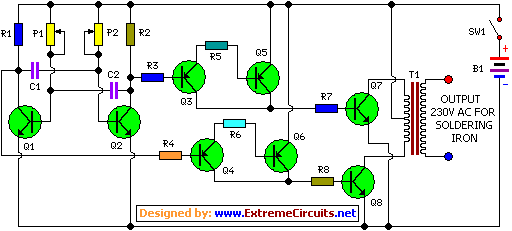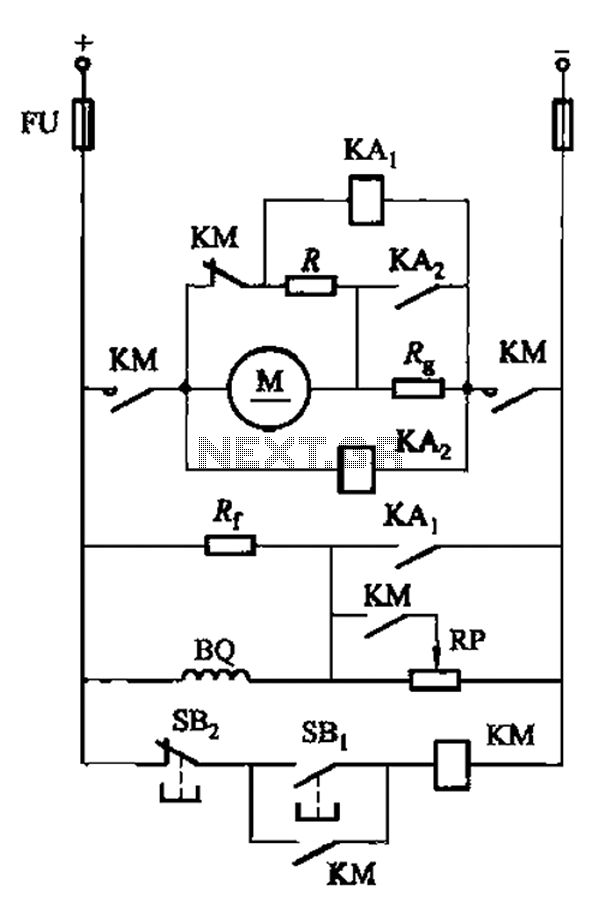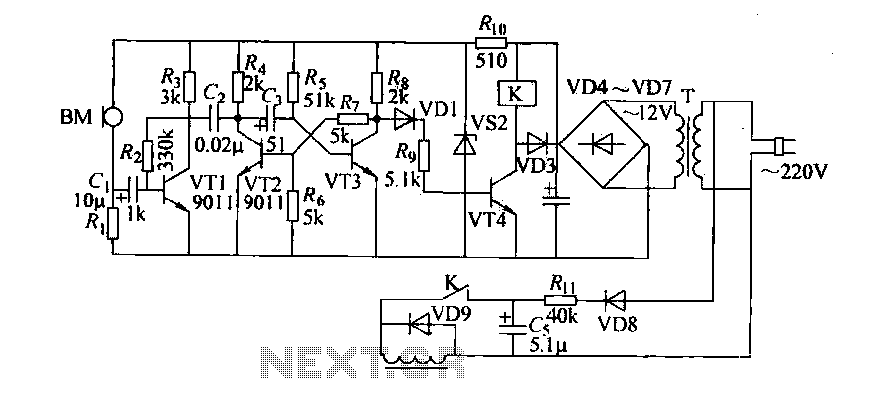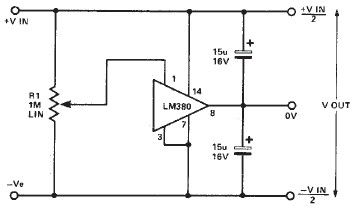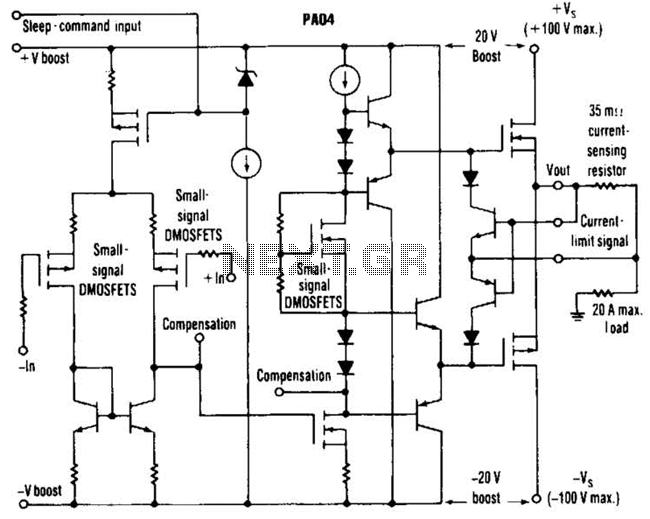
5W Audio Amplifier Circuit based BD139/BD140
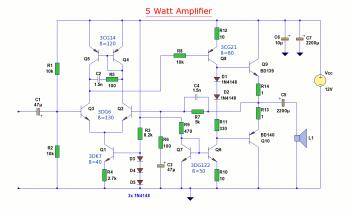
The diagram illustrates a 5W audio amplifier circuit constructed using power transistors BD139 and BD140 for the final amplification stage. This compact amplifier serves as a general-purpose amplifier suitable for applications such as computer audio, radio, MP3 players, and video players. The input stage comprises transistors Q1 through Q5 and three diodes. The biasing for the differential pair is established through Q1, R3, R4, D3, D4, and D5, with a bias current set at 1 mA. Transistors Q4 and Q5 operate as a current mirror, serving as the active load for the differential pair, while the output is taken single-endedly from the collector of Q2. The open-loop gain of the input stage exceeds 60dB. Transistor Q8 functions as a common-emitter amplifier, driving the output stage. The current mirror formed by Q6 and Q7 acts as both the biasing current source and the active load for Q8. The open-loop gain of the second stage is approximately 40dB. Q6 and Q7 are thermally coupled within a blue tube to ensure thermal compensation. The complementary pair BD139/140 is biased using diodes D1, D2, and resistor R10, where adjusting R10 allows for the desired quiescent current. Resistors R13 and R14 are included to prevent thermal runaway in the complementary pair. The DC voltage at the output is maintained at half the power supply voltage. The feedback network consists of resistors R6, R5, and capacitors C3 and C4. The overall gain is determined by the ratio of R6 to R5, with C4 providing lead compensation and C3 serving as a DC-blocking capacitor.
The 5W audio amplifier circuit is designed to deliver efficient audio amplification while maintaining stability and performance across various applications. The choice of BD139 and BD140 transistors allows for robust performance due to their complementary characteristics. The input stage, utilizing a differential amplifier configuration, ensures high input impedance and low output impedance, which is critical for interfacing with audio sources.
The biasing arrangement involving Q1, R3, R4, and the diodes ensures that the transistors operate in the active region, allowing for linear amplification of the audio signal. The current mirror formed by Q4 and Q5 not only provides a stable biasing condition for the differential pair but also enhances the overall gain by maintaining a consistent collector current.
The output stage, driven by Q8, is configured as a common-emitter amplifier, which is known for its high gain and ability to drive loads effectively. The inclusion of Q6 and Q7 as a current mirror helps maintain thermal stability, which is essential for reliable operation, especially in compact designs where heat dissipation may be a concern.
The feedback network plays a crucial role in defining the amplifier's frequency response and overall gain. The values of resistors R5 and R6 can be selected to achieve the desired gain, while capacitors C3 and C4 serve to filter out DC components and provide phase compensation, ensuring the amplifier operates effectively across the audio frequency range.
Overall, this 5W audio amplifier circuit exemplifies a well-balanced design that combines performance, stability, and versatility, making it suitable for a wide range of audio applications.The following is the diagram of 5W audio amplifier circuit which built using power transistor BD139 and BD140 as the final gaining process. This small amplifier can be used as general purpose amplifier such as computer amplifier, radio, mp3 player, video player, etc.
The input stage consists of Q1 through Q5 and 3 diodes. The differential pair is biased by Q1, R3, R4, D3, D4, and D5. The biased current is set to 1 mA. Q4 and Q5 form a current mirror as the active load for the differential pair, and the output is taken out single-endedly from the collector of Q2. The open loop gain of the input stage is more than 60dB. Q8 act as a common-emitter amplifier driving the output stage. Current mirror formed by Q6 and Q7 serve both biasing current source and active load for Q8. The open loop gain of the second stage is about 40dB. Q6 and Q7 are mounted together inside the blue tube to provide thermal compensation to each other. The complimentary pair BD139/140 is biased by D1, D2, and R10. Adjusting the value of R10 can yield the desired quiescent current. R13 and R14 prevent thermal run-away of the complementary pair. DC voltage at the output is always half the power supply. The feedback network consists of R6, R5, C3 and C4. The overall gain is about the ratio of R6 to R5. C4 provides lead compensation; C3 provides DC-blocking. 🔗 External reference
The 5W audio amplifier circuit is designed to deliver efficient audio amplification while maintaining stability and performance across various applications. The choice of BD139 and BD140 transistors allows for robust performance due to their complementary characteristics. The input stage, utilizing a differential amplifier configuration, ensures high input impedance and low output impedance, which is critical for interfacing with audio sources.
The biasing arrangement involving Q1, R3, R4, and the diodes ensures that the transistors operate in the active region, allowing for linear amplification of the audio signal. The current mirror formed by Q4 and Q5 not only provides a stable biasing condition for the differential pair but also enhances the overall gain by maintaining a consistent collector current.
The output stage, driven by Q8, is configured as a common-emitter amplifier, which is known for its high gain and ability to drive loads effectively. The inclusion of Q6 and Q7 as a current mirror helps maintain thermal stability, which is essential for reliable operation, especially in compact designs where heat dissipation may be a concern.
The feedback network plays a crucial role in defining the amplifier's frequency response and overall gain. The values of resistors R5 and R6 can be selected to achieve the desired gain, while capacitors C3 and C4 serve to filter out DC components and provide phase compensation, ensuring the amplifier operates effectively across the audio frequency range.
Overall, this 5W audio amplifier circuit exemplifies a well-balanced design that combines performance, stability, and versatility, making it suitable for a wide range of audio applications.The following is the diagram of 5W audio amplifier circuit which built using power transistor BD139 and BD140 as the final gaining process. This small amplifier can be used as general purpose amplifier such as computer amplifier, radio, mp3 player, video player, etc.
The input stage consists of Q1 through Q5 and 3 diodes. The differential pair is biased by Q1, R3, R4, D3, D4, and D5. The biased current is set to 1 mA. Q4 and Q5 form a current mirror as the active load for the differential pair, and the output is taken out single-endedly from the collector of Q2. The open loop gain of the input stage is more than 60dB. Q8 act as a common-emitter amplifier driving the output stage. Current mirror formed by Q6 and Q7 serve both biasing current source and active load for Q8. The open loop gain of the second stage is about 40dB. Q6 and Q7 are mounted together inside the blue tube to provide thermal compensation to each other. The complimentary pair BD139/140 is biased by D1, D2, and R10. Adjusting the value of R10 can yield the desired quiescent current. R13 and R14 prevent thermal run-away of the complementary pair. DC voltage at the output is always half the power supply. The feedback network consists of R6, R5, C3 and C4. The overall gain is about the ratio of R6 to R5. C4 provides lead compensation; C3 provides DC-blocking. 🔗 External reference
